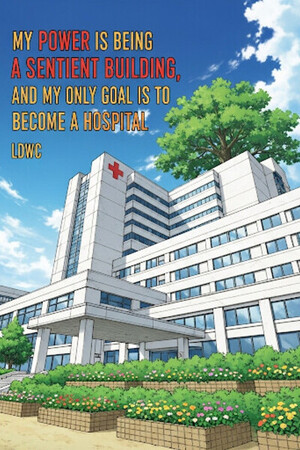Chapter 6:
No Potion in this World
My Power is Being a Sentient Building, and My Only Goal is to Become a Hospital
A low, rhythmic chant, accompanied by the beating of a drum, echoed from the woods, its sound a low thrumming that Ray felt deep within his foundations. He stood ready, a level 2 Sentinel Cabin, scarred but not broken. His vibrating army, silent, was a part of his very structure now, and he felt its readiness in every fiber of his being. This time, there would be no surprise attacks. No unprepared moments. He was a fortress, and his revenge would be served with the cold indifference of an architect looking to correct a flaw in his design.
The Evolution of Healing
For millennia, the idea of a hospital as we know it today was a foreign concept, a blueprint not yet drawn. The earliest forms of organized care were not for the masses, but for a select few. Sinhalese royalty maintained healing houses over two millennia ago, with Chinese monks attesting to the existence of similar establishments 1500 years ago in what would become modern day India. The temples of Asclepius in ancient Greece offered a form of rest and recovery, a sacred space where the sick could find solace and healing through spiritual means. They were places of magic and ritual, not science. In ancient Rome, the military established valetudinaria, infirmaries to tend to the wounded and sick soldiers who were too valuable to lose. These were places of utility, not compassion.
It was with the rise of Christian and Islamic societies that the hospital began to truly take shape. Hospices, originally created to shelter pilgrims and the poor, evolved into centers where the sick were not just housed, but cared for. The emphasis shifted from spiritual healing to physical recovery, from ritual to charity. The early Muslim world led the way with magnificent hospitals that admitted patients regardless of their faith or social standing, creating a blueprint for the modern, universal care system.
The Middle Ages saw monasteries become central to healthcare, with infirmaries becoming a standard part of their structure. In India and China, sultans and emperors expanded the care systems of old to take a more public approach, with government funded hospitals for the masses becoming more and more prevalent. But it was in the Renaissance and later, the Age of Enlightenment, that the hospital moved beyond charity and became a place of science. Physicians and surgeons, seeking a place to practice and to learn, transformed these institutions. The focus became less on providing comfort and more on providing a cure.
By the 19th century, with the discovery of germs and the advent of antiseptic practices, the hospital as a place of death began its slow, painful transformation into a place of life. Architects like Ray began to design them not just for function, but for aesthetics, for light, and for cleanliness. They became symbols of hope, monuments to human ingenuity and compassion. The hospital had finally arrived.
The modern hospital is a testament to this long, winding journey. As technological hubs, hospitals are the frontline responders in times of crisis. They are a cornerstone of modern society, a place where life is saved and extended, where diseases are fought, and where the next generation of healers is trained. More than just building, they are the very pillars of health and well being.
Children’s hospitals are an even more critical piece of this puzzle. They are designed and staffed by specialists who understand the unique needs of children, both medical and emotional. They are a safe space where children can receive care without fear, surrounded by people and things that are designed to make them feel safe. They serve as regional centers for children’s health, and are a disproportionately large source of research and training for pediatric care. They are, in a word, essential.
For many, the idea of a broken bone, a deadly infection, or a long recovery is relegated to the digital realm. We, in our modern world, navigate a daily landscape of taxes and political action to support a sprawling, complex healthcare system. But in our games, we have the opposite. With the simple push of a button or the use of a magical potion, we can mend our bodies and return to battle. Healing in video games is a commodity. It is unlimited, immediate, and accessible. In a world of capitalist realities, this digital escapism offers a fantasy of perfect health and security. We can only wonder if the pervasive nature of healing in modern gaming is not a form of healthcare escapism, a core part of the modern gaming ethos that allows us to briefly forget the fragile reality of our own health.
Ray’s son had been an avid player of these games. He would often spend hours in the living room, his friends gathered around, their laughter and shouts filling the air. Ray would listen, a quiet smile on his face, as his son described his characters victories, his miraculous recoveries, his quick returns to battle. Ray’s boy had a heart of gold and a body that was too frail for this world. He fought a disease that would not yield to a magical potion or a reset button. Ray had watched as his son’s light slowly dimmed, a silent observer to a battle that had no victor. He watched the hospital beds grow scarce and the doctors become overworked. He had watched as his son had been a victim of a system that had not been designed for him.
Ray remembered his son’s bravery and his pain. He remembered the unfulfilled hope, the shattered dream. He had failed to build a children’s hospital in his previous life. He would not fail to build it in this one. He did not know how he would get there. He did not know what it would cost. He only knew that he would not rest until every child had access to the healing they deserved, even if it was only in this peculiar parallel world. He was an architect, and he would build his masterpiece. He would make healing accessible to the most vulnerable of populations. He would make it a reality.




Please sign in to leave a comment.